- Author Jason Gerald [email protected].
- Public 2023-12-16 10:50.
- Last modified 2025-01-23 12:04.
Painting your nails is a great way to beautify your feet, especially in summer when your feet are constantly visible. Always clean and trim your nails first to create the perfect “canvas” for your favorite color, then apply primer, nail polish, and clear/cover polish. If you want a bolder color, try techniques for creating unique designs and colors.
Step
Part 1 of 3: Cleaning and Trimming Toenails
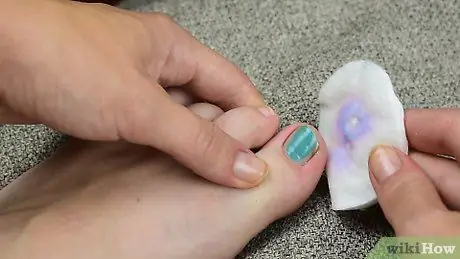
Step 1. Remove the old nail polish if any remains
Wet a cotton swab with nail polish remover. Hold it on your nails for 15-30 seconds, then wipe with a dry cotton swab. Repeat on all toenails, and replace the cotton when it gets dirty.
- Use cotton swabs to reach nooks and crannies.
- When choosing a nail polish remover, be aware that brands that contain acetone are more effective, but can also damage the skin. On the other hand, non-acetone nail cleaners are weaker, but are also safe on the skin.
- You can also clean your nails without a nail polish remover.
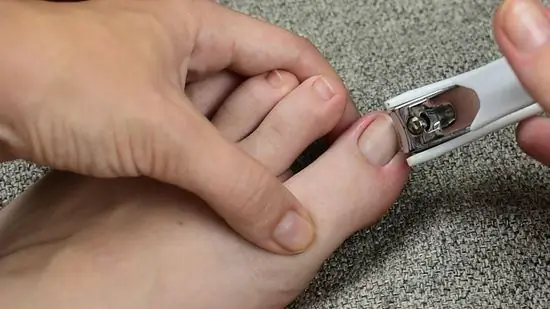
Step 2. Trim your toenails straight so they aren't too long
Choose a special nail cut for the toes because they are bigger and stronger. Trim your nails at the tips, and make sure not to cut them too short as this could hurt yourself.
- Cutting straight reduces the chance of ingrown nails.
- To make the process easier, trim your nails after bathing as they become softer. You can also soak your feet for 5-15 minutes in warm water.
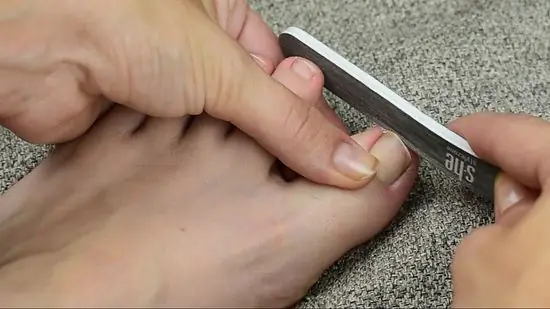
Step 3. File the toenails into the desired shape
Use a smooth emery board or nail file. Smooth the toenails by blunting the edges, and make sure you're always working in the same direction, and not back and forth. If the file is not smooth, the edges of the nails can get caught in socks, clothes, and bed linens.
- If you want a more square nail shape, just make sure to blunt the corners after the toenail is trimmed. If you want a rounder nail shape, trim it to the shape of your toe and smooth out any sharp edges of the nail.
- Make sure the nail file is in good condition. Over time, the edges of the file can wear and soften so that it is much less effective.
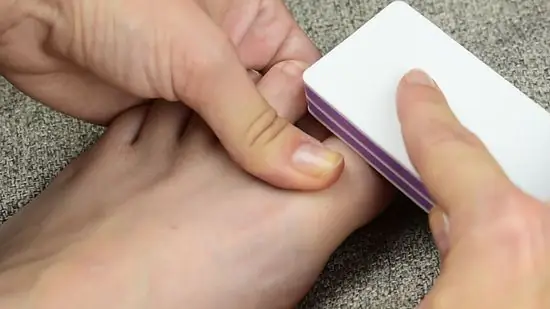
Step 4. Polish the top surface of the nail with nail buffer
Like fingernails, toenails will become more prominent over time. Use the roughest side of the buffer first, and work in a motion that forms an “X” across the surface of the nail. Switch to a smoother buffer surface for a shinier surface.
- Glossing your nails helps to clean up any residue from an old pedicure and prepares the surface of your nails before applying the base polish.
- Don't use the rough side of the buffer more than once a week as it can scrape off too much of the nail.
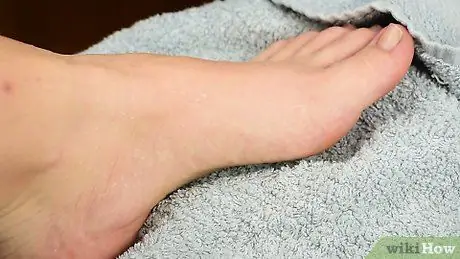
Step 5. Rinse and dry feet
Wash your feet with soap and water to remove nail polish remover and any leftover filings and polishes. Dry your feet completely, as water will make it harder for the polish to stick to your nails.
Part 2 of 3: Painting Nails

Step 1. Separate the toes using a finger separator or a cotton ball
Place one divider between each toe. If you don't have a separator, use a cotton swab or simply roll up a tissue. You just want to keep the toes apart. That way, your work won't be damaged by fingers touching each other.
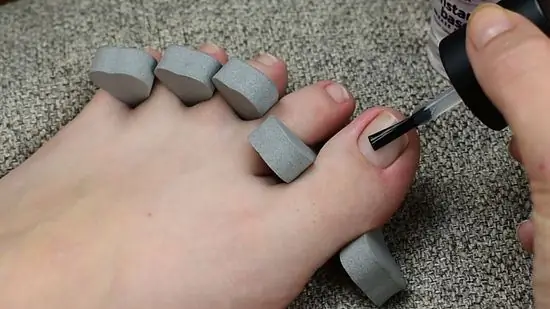
Step 2. Apply base polish on toenails
Take a brush from the base polish and apply a drop to the base of the nail near the nail bed. Apply the base polish to the center of the nail, then apply from the base of the nail to the tip of each nail until it is completely covered.
- Base polish will also help the pedicure last longer as it helps the paint to adhere better to the nails.
- Allow the basecoat to dry completely before applying the nail polish.
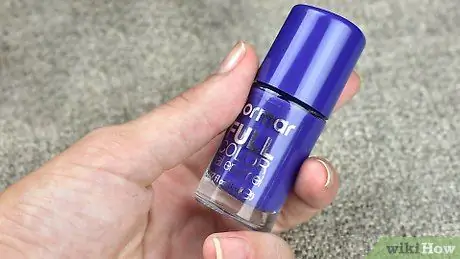
Step 3. Choose a nail polish color
You are free to choose the nail polish color! Choose the color you want to wear in the next 1-2 weeks. You can choose your favorite color or one that matches the season. You can even just use a primer and cover for a plain look.
For summer, try coral pink for a bright, bold look that's not too red or playful. Marigolds are great for a sunny afternoon, or try pale lavender for something lighter
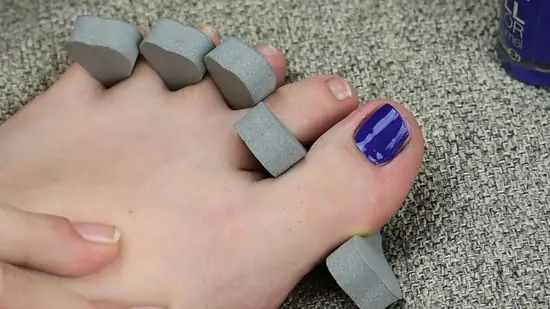
Step 4. Apply the selected nail polish color
Dip the brush in the nail polish and run it over the lip of the bottle to remove excess paint. Move the paint from the brush to near the surface of the nail bed. Then, gently rub it into the center of the nail. After that, apply once to each side of the nail so that the polish is evenly distributed on the nail surface. Maybe you need another drop of nail polish for your thumb, or half for your little finger.
Make sure the paint is applied lightly. A thick layer can produce air bubbles, and it will take a long time to dry. What's more, nail polish tends to peel off if you apply a thick coat
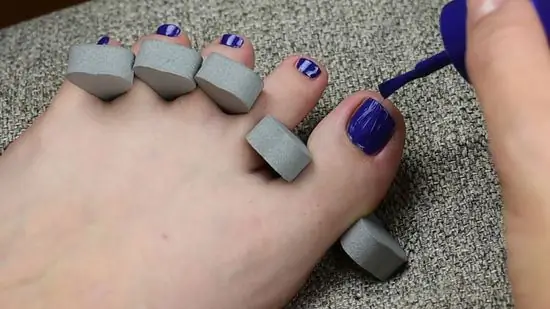
Step 5. Add a few more layers for best results
Wait at least 2 minutes for the first coat of paint to dry. Apply the same method to applying polish, starting with a small drop near the nail bed. Do 3 strokes to spread it evenly on the nail surface. You need to reduce the amount of polish you use for your pinky nails.
Two coats of paint should suffice, but you can repair the areas as needed after the paint has been allowed to dry. If two layers are still too thin, feel free to add another layer
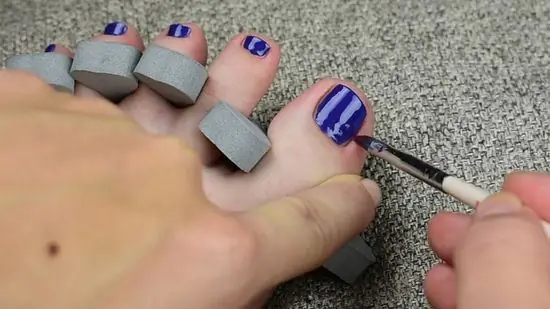
Step 6. Clean the remaining paint with a cotton swab or lip brush
Don't worry if you smear your nails; everyone has experienced it! Dip a cotton swab or an old, clean lip brush into the nail polish remover. Rub it on the nail polish that is staining the skin around the nail.
You can also wipe the stained skin off as soon as you finish painting your nails. This way, some of the paint can be removed

Step 7. Finish by applying cover paint
Once your nail polish has dried, apply the same method to applying the cover polish. Start with a small drop at the base of the nail and work your way down the tip along the center and each side of the nail. Also, rub it past the tip of the nail so it doesn't break easily.
- Choose a cover paint that is long dry because it provides more protection.
- The clear cover paint will ensure your pedicure lasts longer. It also adds shine or opacity to the appearance of the nails, depending on the type chosen.
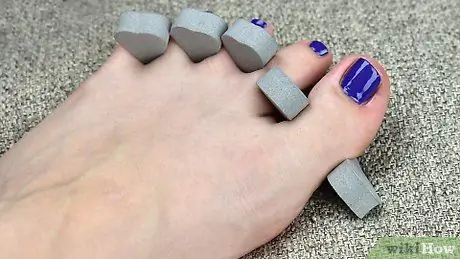
Step 8. Let the toenail dry completely before removing the finger separator
Try to keep your toenails out of the way while they're still dry. The fruits of your labor can be ruined! When it's completely dry, remove all of your toe separators.
If you're in a hurry, soak in cold running water for a few minutes. However, do not use hot water because it can crack the nail polish

Step 9. Apply cuticle oil to the nail bed after the nail polish dries
Choose a cuticle oil that contains jojoba oil which is great for adding fluid to your nails. Drop a drop of cuticle oil on each nail bed, and rub it in with your fingers.
Cuticle oil helps keep fingernails hydrated for a healthier appearance. Plus, the surface of the nail becomes a bit slippery so that the paint doesn't come off easily
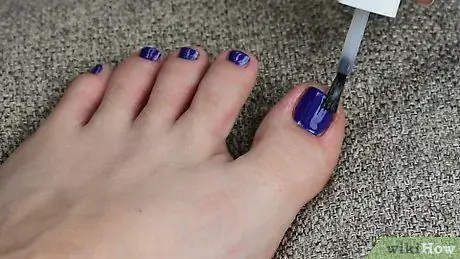
Step 10. Reapply the cover paint every few days
Re-applying the cover paint will help maintain the longevity of your pedicure. Focus on the tips of the nails, which usually break easily. Make sure the cover paint is completely dry before you put on the shoes.
You can apply quick-drying nail polish for this step, as long as you apply an additional layer of protection to your nails
Part 3 of 3: Creating Interesting Designs and Colors
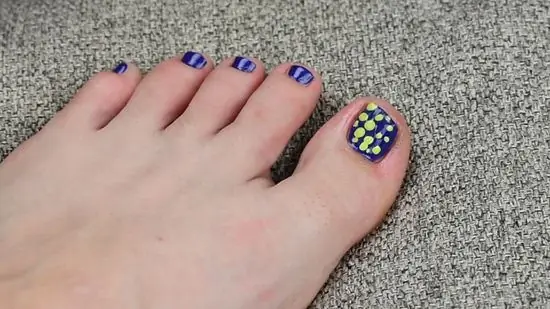
Step 1. Create a polka dot pattern with hairpins in a contrasting color for a cheerful look
Apply nail polish according to the color of your choice, at least 2 layers. After the nail polish dries and before applying the cover polish, make a polka dot pattern on the nails. Open the bobby pins and dip the ends in the paint. Make dots on the nails, and dip the bobby pin back in the paint as needed.
- Don't forget to apply the cover paint at the end.
- Try a combination of white base colors with rainbow polka dots for a fun effect!
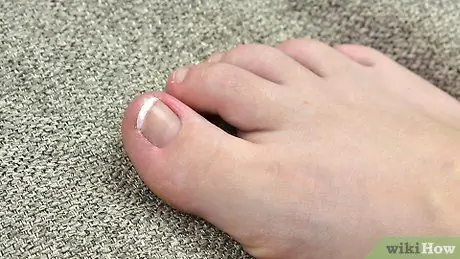
Step 2. Choose a simple and elegant French pedicure
After applying the primer and letting it dry, run a thin white strip along the tip of the toenail. This is the French manicure effect. Apply two coats so that the white strips are quite clear.
If necessary, cut the masking tape so that it curves slightly and fits snugly against your fingernail, then attaches it to the nail under the tip. This tape will serve as a stencil, which is enough to peel off when you're done
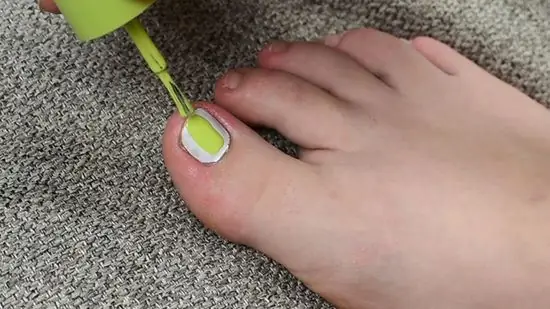
Step 3. Create a striking neon color by applying white paint behind it
Since colors tend to be more transparent, white paint helps to make them appear more vivid. Apply a base coat, then apply white nail polish as the first coat. Next, apply 2 coats of neon color on top of the base coat.

Step 4. Apply nail stickers or tattoos for a effortlessly vibrant design
Apply two coats of your primary paint color. Then, stick the stickers in place on the nails, and apply a coat of paint to seal them.
You can also apply it after applying the base coat without including the color
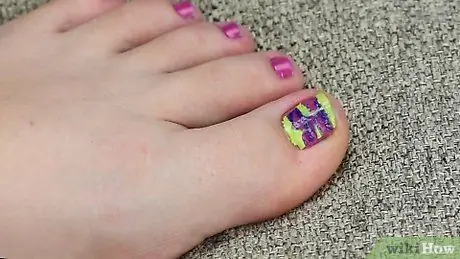
Step 5. Divide the nails with masking tape for a sophisticated block effect
After applying the basecoat and letting it dry, apply masking tape and apply it along the toenail. You can divide your nails into top and bottom, or left and right, or even diagonally! Apply 2 coats of polish on your nails, and allow to dry between each coat. Pull off the tape, then apply it to the newly painted nail to protect it. Apply another color of paint on the unpainted side.
Try colors that are close together on the color wheel, such as orange and yellow or blue and purple
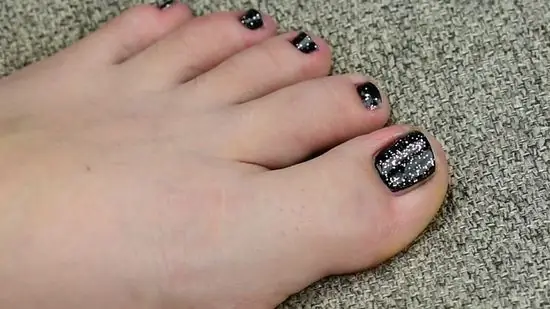
Step 6. Add a transparent shine to the nails for a glamorous look
Apply primer and apply 2 coats of your favorite paint color. Choose opaque so that it stands out. Apply a layer of transparent metallic color over it, such as gold or silver, then seal it with cover paint.
- Try a teal and silver color combination, or red and gold.
- You can also do the same with glitter nail polish instead of metallic colors.
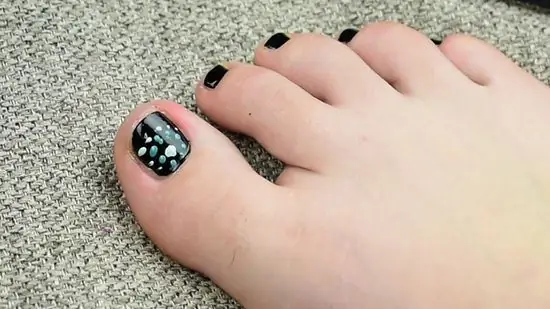
Step 7. Create your own design for a unique look
Apply a base coat and two coats of your nail polish color. Use a very thin brush and draw the design on the nails. Try drawing feathers, flowers, geometric shapes, sun/stars/moon, or hearts. Create your own design!
Seal with cover paint when the design is dry
Tips
If the paint is quite thick or clumps, dilute it with a few drops of nail polish thinner (you can buy it at a pharmacy or cosmetic store)
Warning
- Make sure not to paint your nails every few weeks. Nail polish tends to dry out your nails, allowing fungus and bacteria to thrive. Rest for a few weeks at a time.
- Do not shake the nail polish bottle as this can cause air bubbles. To mix the nail polish, roll the bottle in the palms of your hands.
- Don't cut your cuticles, as they will be prone to infection.






